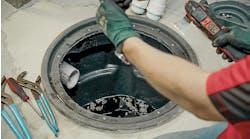"Help — our water heater is leaking and we need an estimate for a new one."
In addition, a few questions during the phone call revealed they would be interested in pricing for a new furnace and central air conditioning. This is a new potential customer who was referred by a friend of theirs who is a customer — the best kind of introduction.
The water heater was leaking, just not internally. It was an indirect-vent, exhaust only vented to the outdoors, natural-gas model with a very long run of 3-in. PVC that wrapped around two sides of their basement. The indirect vent line was pitched back towards the water heater: a condensate-drain tee with its loop of ½-in. OD vinyl tubing coiled to create a liquid trap was installed just before the exhaust turned down to meet the water heater’s draft-inducer fan.
In theory, they should be generating about 1- to 3-gallons of condensate per day (family of four, but no teenagers yet) and at a fairly slow rate that would enable the condensate drain to handle the load. There's just one hitch in this condensate giddy-up: the vinyl tube drops straight down through a sloppily calked hole in the basement's concrete floor. No doubt it overflowed before, and the calk was designed to seal the penetration! The leak they'd noticed was being generated from condensate that was flowing past the all-too-slow condensate drain. Acidic in nature, it had wreaked havoc with the water heater's metal components and, now, its outer jacket, leaving an ugly wet brown rust-streak behind. Gently tugging the vinyl tube from its drilled-concrete termination revealed a snot-cicle that oozed from the clogged end of the drain. Condensate drained freely to run across the floor. Why would anyone install the drain like that?
Glancing over to the 92% efficiency condensing furnace and central air conditioning, it was obvious we were looking at the same handyman's work. I won't refer to him as a pro here for reasons that will soon be obvious. Not only was the furnace condensate drain terminated into a hole in the concrete floor, also with a mounded-up ring of calk, the condensate drain from the air conditioning coil was installed without a trap and the two were joined to run together into the bed of sub-slab stone. This drainage-bed was also filled with snot-like ooze, no doubt teeming with life-forms best left in what would soon be a sealed-off tomb.
Aside from the biohazards created by installing condensate drains in such an unprofessional manner, the absence of a trap on the A/C drain creates several known problems:
- Air rushing upwards past the catch basins (more like half-round spouting positioned under the vertical A-coil) creates a venturi effect, just like the venturi in a jet-pump’s foot-valve that draws air backwards up through the drain. It’s not uncommon for the venturi effect to be strong enough that the condensate catch-basin fills to overflowing, which drips down onto the furnace heat exchanger. Premature failure and CO (carbon monoxide) issues become a danger. Evidence would become clear that this had been occurring during the installation of new equipment.
- Radon is often present at high levels in basements nearby this home. The EPA threshold is listed at 4 picocuries per liter and her immediate neighbor’s home (the referral customer) had a 23 count. Check out this link to view the EPA Map of Radon Zones: www.epa.gov/radon/zonemap.html. The absence of a condensate trap, therefore, turns the air-flow into a radon vacuum drawing sub-slab contamination into the home every time the furnace or A/C is running, 3,050-run-hours average each year in my neck of the woods.
Reminds me of the time I flagged a home certification for the missing A/C condensate trap. The owner works for a major manufacturer of heating and A/C equipment in my area and was being relocated. You'd have thought I shot his dog! He chewed on me for a good fifteen minutes during his irate phone call. When he'd finally run out of nasty words, I politely asked him to look up the I&O (installation & operation) manual for the model A/C equipment he had in his home manufactured by the company in York he works for. I gave him the page number with the explicit instructions that a trap was to be installed and offered to e-mail him the PDF file: he hung up. All that fuss over less than $5.00 in materials? The other issue that frosted his pumpkin: he had hard-piped the gravity condensate drain into the laundry trap and its overflow was higher in elevation than was the condensate catch-basin inside the furnace. He couldn’t see how he could drain the condensate any other way. Bathrooms upstairs and that laundry trap A/C condensate drain hard-piped cross-connection was the lowest-overflow-point for a sewage back-up!
Condensate pumps are inexpensive, reliable and almost too easy to install. Vinyl tubing can often be run to terminate in a safe-waste and there's plenty of room beside the discharge hose from a clothes washer. Don't cinch-down the zip-ties too tightly while routing the vinyl tubing from pump-to-termination or flow will be restricted or cut-off completely. Avoid through-the-exterior-wall terminations if you live in an area subject to freezing outdoor weather.
Dave Yates owns F.W. Behler, a contracting company in York, Pa. He can be reached by phone at 717/843-4920 or by e-mail at: [email protected].
All Dave Yates material in print and on Contractor's Web site is protected by Copyright 2011. Any reuse of this material (print or electronic) must first have the expressed written permission of Dave Yates and Contractor magazine. Please contact via email at: [email protected].

